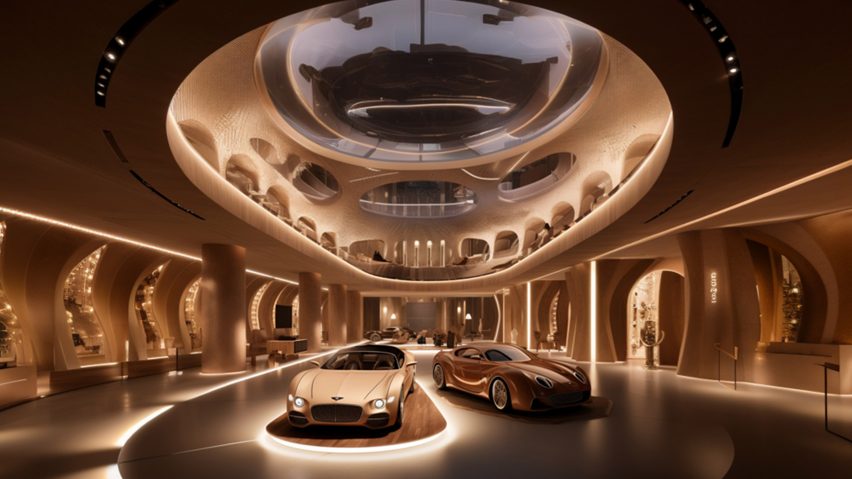
Fifteen designs shortlisted in Dezeen and Bentley's Future Luxury Retail Design Competition
Fifteen innovative designs have been shortlisted for Dezeen and Bentley's Future Luxury Retail Design Competition, which called for concepts that reimagine the future of luxury retail.
Over 145 entrants from more than 33 countries around the world entered the contest, which challenged architects and designers to envisage what luxury retail could look like in 2030 and beyond.
Through the competition, Dezeen and Bentley sought to discover forward-thinking ideas for both digital and physical luxury retail experiences of the future, in and out of the automotive world.
Entrants were tasked with designing any retail experience in the world of contemporary luxury lifestyle, whether it be real-world, digital, or a combination of both.
Fifteen designs have now been shortlisted and are in the running for a share of the £30,000 prize pot. The winners will be revealed later this month.
The winner will receive a top prize of £15,000, while the runner-up will receive £10,000 and the third-placed entrant will receive £5,000.
The shortlisted entries are listed below in the order that they were submitted. Automotive models shown in imagery are not associated with Bentley.
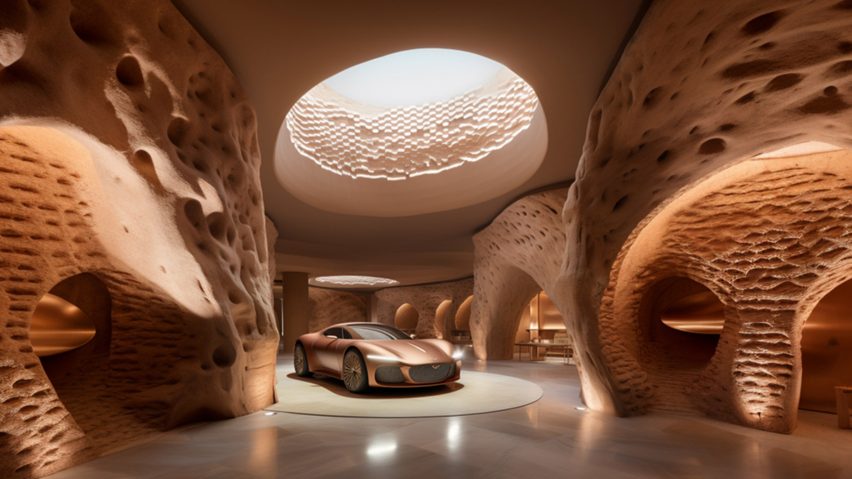
W13: The Bentley Wellness Hotel by Monte Reed
Philadelphia, Pennsylvania, USA
Monte Reed imagined a wellness hotel that imbues Bentley's heritage and design prowess to "seamlessly blend modernity with timeless elegance".
The hotel, which is characterised by its "earthly atmosphere", features a spa that merges ancient healing practices with advanced technologies to offer bespoke treatments and enhance rejuvenation and relaxation.
Each hotel room is designed to reflect the craftsmanship and aesthetic of specific car models, from Bentley's Continental GT to its Flying Spur car.
Throughout the hotel, each space is furnished with Bentley-designed furniture to complement the interiors and showcase the brand's craftsmanship.
"W13 goes beyond traditional hospitality, offering a transformative experience embracing sustainability," Reed said. "It's a wellness retreat that empowers guests on a journey of self-discovery, guided by tailored programmes in mindfulness, nutrition and fitness."

Roam by Sam Mcheileh and Caitlin Ure
New York City, USA
Sam Mcheileh and Caitlin Ure created a retail experience called Roam, which applies the convenience of automotive mobility to Bentley-branded architecture and real estate.
The concept aims to offer a more immersive and personalised experience when purchasing real estate, which currently requires buyers to physically visit sales suites in which 2D floor plans, visualisations and mock-ups are presented, leaving buyers to use their imagination.
Instead, Mcheileh and Ure propose an omnichannel alternative, which includes a physical one-to-one appointment and a hybrid immersive mixed-reality experience. This, in turn, eliminates the need for the construction of unsustainable, temporary display suites.
When clients make an appointment, a self-driving Roam vehicle arrives at their doorstep. In the upper space, clients can opt to use the Concierge mode, which enables them to make selections on the layouts, materials, finishes and fixtures of their residence; or the Vision mode, in which the interior space transforms to depict their selections through an immersive display.
Each Roam interior can be fully customised to the client's preferences including ambiance, scent, lighting levels and refreshments. The vehicles are fully powered by solar energy via panels fixed on its exterior skin.
"Roam offers a memorable experience that is tailored to personal preferences, comes direct to the individual, and is thoughtfully enhanced with technology," the designers said.
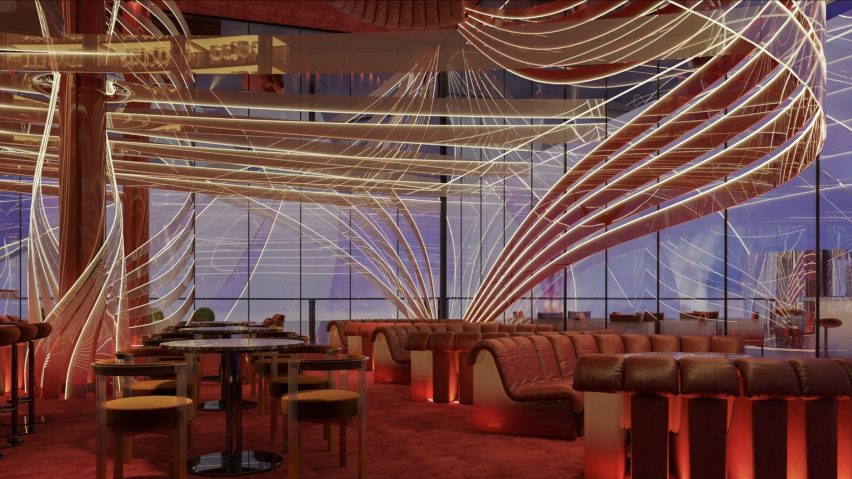
Quantum Bar by Louis Zhang Studio
London, UK
Louis Zhang Studio designed a futuristic concept bar set in London's St Paul's Cathedral. Called Quantum Bar, the shell of the bar is made with transparent photovoltaic solar glass as a nod to Bentley's solar car park in Crewe.
The bar features undulating transparent "branches" to emulate the dome of the cathedral and offer unobstructed views. Other elements are designed to echo the aerodynamics associated with motor sports and automotive engineering.
Visitors to Quantum Bar would be greeted with an artificial intelligence (AI)-enabled smart device upon arrival. This scans a QR code that analyses client preferences, interests and behaviours, as well as market indicators for seasonal food and drink in order to make personalised recommendations.
"An understanding of the origin and heritage of luxury goods is becoming increasingly important," Zhang said. "Often, clients encounter drinks they love, but have very limited knowledge of which food should be paired with that drink."
"AI's predictive capabilities provide clients with a richer, more fulfilling experience," he continued.
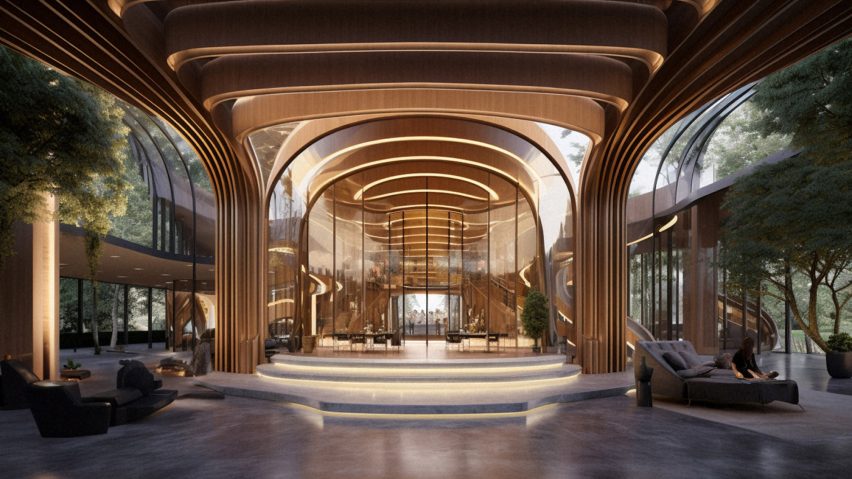
Bentley World by Christoffer Rostvad and Jonathan Udemezue
Copenhagen, Denmark
Christoffer Rostvad and Jonathan Udemezue designed a sinuous experience centre characterised by "sustainable luxury".
The centre would be composed of glulam timber, selected for its durability, renewability and ability to embed carbon and reduce emissions.
It is zoned into various spaces that showcase different aspects of the Bentley brand. This includes a showroom displaying its latest models and innovations, a lounge for relaxation and socialising, a workshop that enables customers to personalise their vehicles and a gallery exhibiting Bentley's history and heritage.
The centre would also features a VR room that allows customers to envisage Bentley cars in different landscapes. The space is a Web3 platform accessible through AR/VR headsets and allows customers to try on clothes, accessories and cars in realistic settings, enabling them to feel the materials and textures through haptic feedback and co-create with online designers using AI tools.
"Our design will create a space that celebrates Bentley's values and vision, providing an immersive and personalised customer journey that will enhance loyalty and engagement," the designers said.
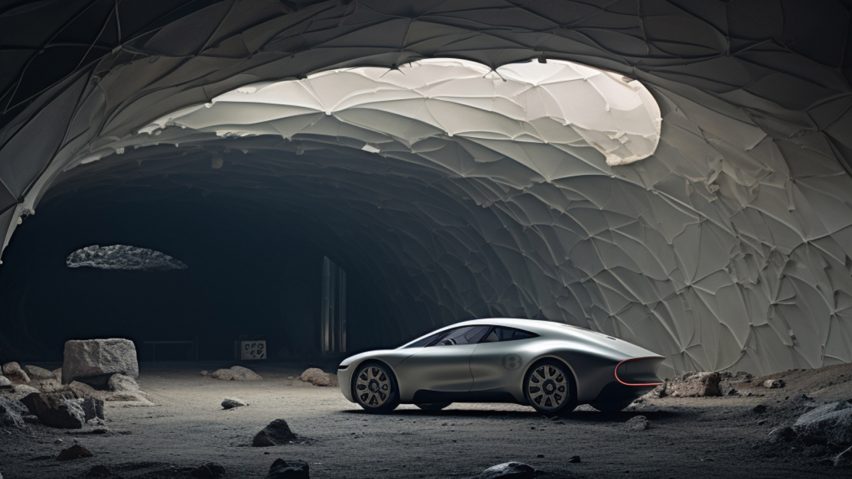
Bentley Moon Rally 2030 by Luca Rizzi Brignoli and Fang Zhou
Shanghai, China
V10 co-founders Luca Rizzi Brignoli and Fang Zhou imagined a mirthful lunar experience, made possible by significant advancements in space travel technology accompanied by artificial intelligence.
The concept sees 100 drivers invited to compete in a qualifying race held at Bentley's headquarters, with the top 10 earning a coveted spot in the Bentley Moon Rally.
On their travels to the moon, participants of the race would be treated to an all-encompassing luxury experience, which includes the assistance of a personal tailor who designs custom space suits created with 3D body scans, as well as specialised lunar travel equipment and gourmet food that is tailored to suit each driver's preferences and collected wellness data.
A select number of guests would be invited to the Bentley Arena on the moon for a special viewing experience of the race. AR/VR headsets would be provided to enthusiasts around the world, to create an immersive and engaging experience for those back on Earth not in attendance.
"The Bentley Moon Rally 2030 heralds a new era of automotive adventure, fusing technology, luxury, and the boundless wonders of space exploration," said the designers.
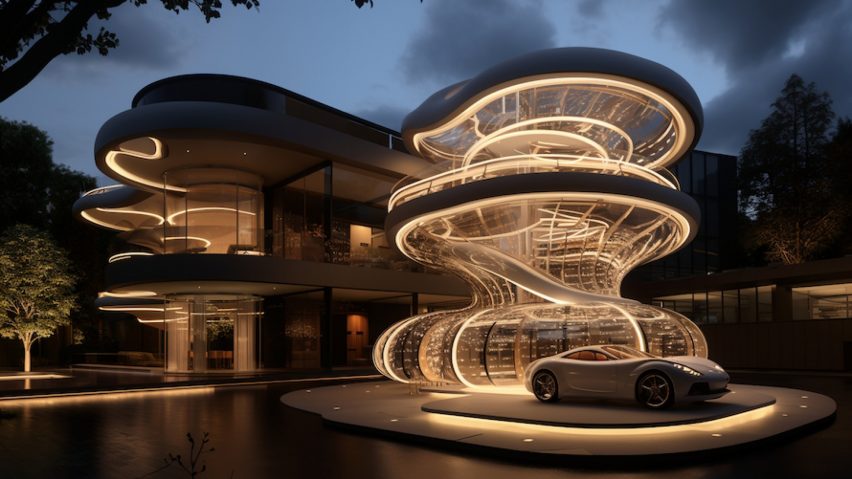
The Crossing by Meredith O'Shaughnessy
London, UK
Meredith O'Shaughnessy designed The Crossing, a concept that repurposes urban multi-storey car parks into luxury retail and entertainment spaces.
Each level of the multi-storey space is designed to be a unique experience of its own. On one floor, guests would be able to visit a high-tech speaker room that doubles as a listening booth using Bentley's in-car audio technology, as well as a concert venue.
Another floor would feature a whiskey bar in which guests can enjoy Bentley Bee honey-infused cocktails, while on the top floor there is an exclusive section for media and VIP guests to explore Bentley's material innovations. These include mycelium-grown leather and haptic experiences with seats made using MotorSkins, which are robotic fabrics embedded with fluidics that hug the body.
A distinctive feature of the concept is the driving track, which extends around the building and onto the roof. Using projection mapping, customers can choose pre-set programmes that adapt the track to create an immersive personalised grand touring experience, simulating scenic drives through Britain's landscapes.
"The Crossing pioneers a new era of luxury automotive retail, transforming sterile showrooms into vibrant brand hubs where education, entertainment and experience effortlessly combine," O'Shaughnessy said.
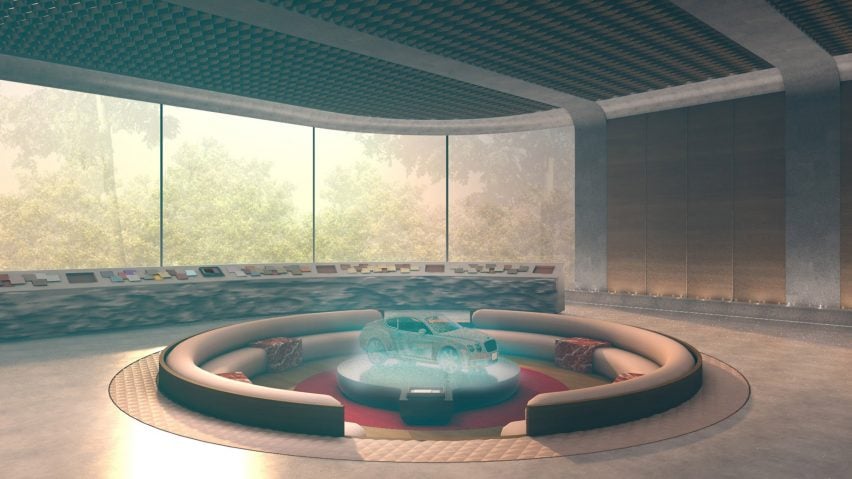
The Bentley Future Archive by Landor & Fitch
London, UK
Design studio Landor & Fitch envisaged a retreat nestled on a tidal island along the UK coastline, crafted from local island materials and powered by renewable energy. It comprises a customisation centre, a showcase space, spa and wellness facilities as well as exhibition and hospitality spaces.
Accessed via a tidal causeway, the experience begins with visitors descending into the Hidden Vault, which features a sculptural interpretation of the iconic Bentley wings encompassed by an expansive collection of non-fungible token (NFT) digital artworks.
The Showcase Space features a mechanised floor that would be used as a dynamic stage for events such as car exhibitions or fashion shows. The hydraulic platform floor panels could be arranged to reveal a central table and seating made from reconstituted stone sourced from the island.
The Sunken Studio is a customisation space that would enable visitors to browse and hand-pick from a vast library their preferred materials and finishes to design their own Bentley vehicle. The space features a central table that displays a digital depiction of the visitor's car as they select and place samples on the table.
"The Bentley Future Archive emerges as an environmentally conscious sanctuary," said the designers. "The thoughtful and sympathetic design ensures a construction that will leave a lasting legacy Bentley can be proud of."
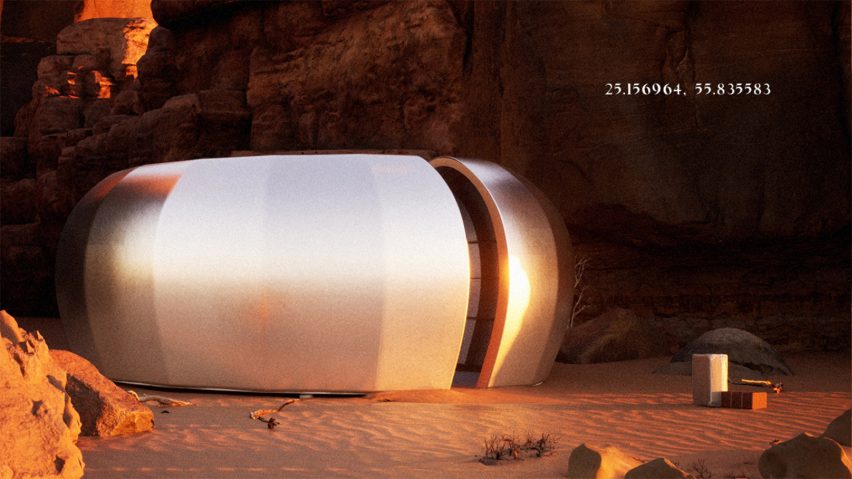
Bentley Intercontinental Pavilion by Ultra
Helsinki, Finland
Design agency Ultra created Bentley Intercontinental Pavilion, a series of invite-only temporary pavilions situated in four selected locations around the world, composed of locally sourced materials and built by local craftspeople.
The pavilions were designed to showcase an imagined series of Bentley cars called Intercontinental, which would have four versions that feature local materials to reflect the unique culture of each location.
Customers interested in owning a vehicle in the special series would be invited to the location that reflects the origin of the specific model they are interested in. Each pavilion is designed to harmoniously blend with its natural setting.
Within the pavilion, final selections on the details, finishes and materials of the cars are made in collaboration with local artisans. The interior of each pavilion is purposefully restrained, enabling the space to come alive through an AR experience that aids customers in making final decisions.
When the pavilion is no longer needed, it can be dismantled without leaving a trace.
"This temporary space celebrates Bentley's commitment to sustainable luxury and craftsmanship while reflecting the essence of each location," the designers said. "It's an invitation to explore local artistry and craftsmanship in selected locations."
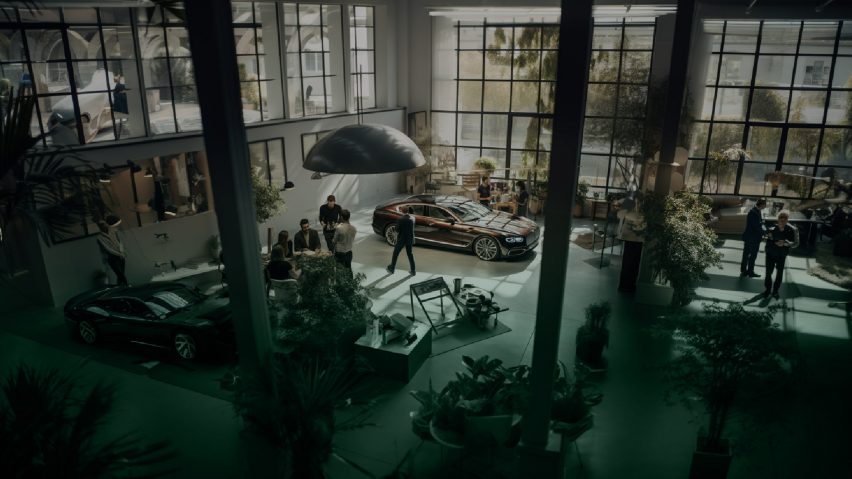
The Bentley Elysium Circuit by Manfred Loeprich
Stuttgart, Germany
Manfred Loeprich designed The Bentley Elysium Circuit as a "luxury retail journey that intertwines the brand's iconic heritage with its electrified future."
The concept makes use of AR and VR technologies to enable customers to explore Bentley's electric models, learn about the brand's history and take virtual test drives.
Utilising AI, the experience was designed to tailor the journey to each customer's unique tastes and preferences.
It would feature a design studio that allows customers to co-create their vehicle with artisans, a sustainability pavilion showcasing Bentley's green initiatives and journey to electrification, as well as a heritage corridor that invites visitors to explore Bentley's history and innovations.
"The Bentley Elysium Circuit is a futuristic sanctuary where technology, heritage and luxury converge, providing a compelling preview of Bentley's electrified future," Loeprich said.
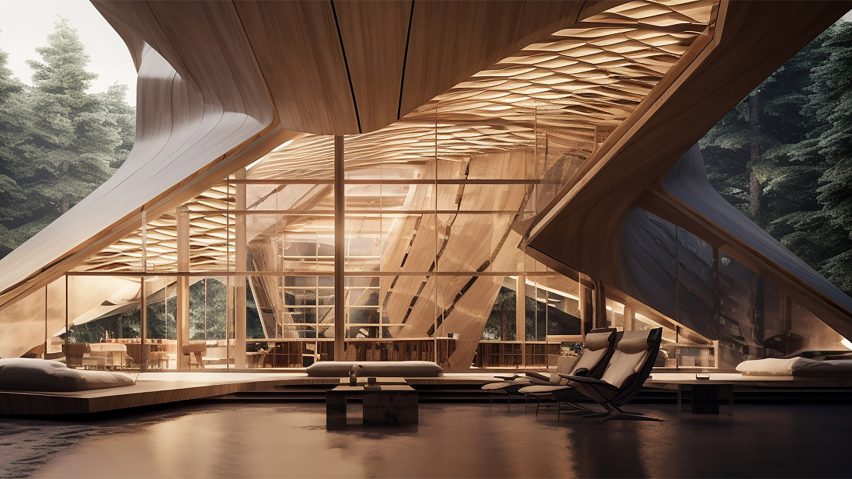
Inhabiting Fascia by Sara Martinez Zamora and Mario Serrano Puche
London, UK
Inhabiting Fascia is a fabrication system proposed by Sara Martinez Zamora and Mario Serrano Puche to create the architectural interiors for Bentley retail spaces and furniture for Bentley Living products.
As a nod to Bentley's craftsmanship and the use of veneered wood and bespoke marquetry in the brand's car interiors, the concept employs a digital manufacturing process in which sawdust is mixed with an inorganic binder to produce soft, tactile wooden objects using 3D printing.
The combination of 3D printing with sawdust would enable a high level of customisation and flexibility, in that each piece or interior can be algorithmically determined to generate bespoke designs for each user and for varying scenarios, ranging from furniture and room dividers to bespoke aggregations.
Each piece would be composed of an outer shell and an inner core, which allows for customisation of the outer skin while keeping the structural integrity and scalability of the system. The inner core allows for easy connection and assembly, while allowing the exterior to be customised to each user's preference.
The designers envisioned the creation of a software platform that allows users to design private and public areas of any room, along with sections for ergonomic actions such as sitting, storing and shelving, as well as enabling them to decide the level of porosity desired for each element.
"As architects and designers, we must define a future for interiors that is non-destructive and non-extractive, which considers the environmental impact of the construction industry," the designers said. "Our proposal fosters a sense of open-endedness, forever reshaping itself to better meet the needs of the user."
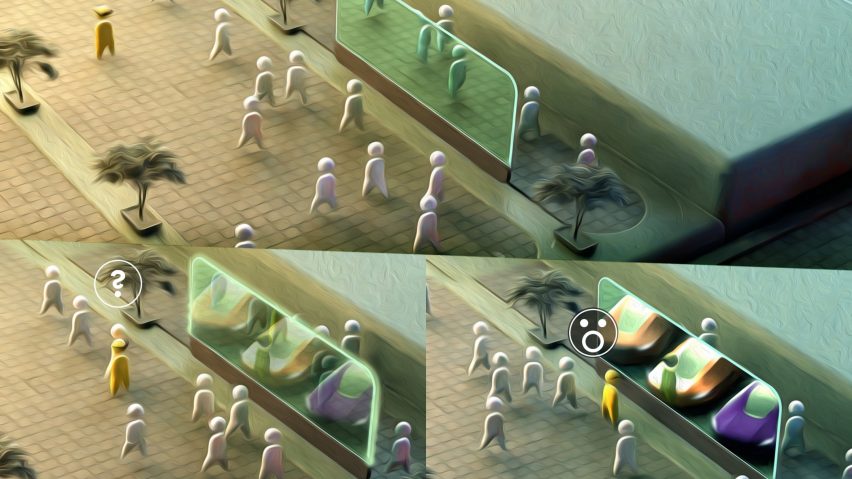
BExperience by Daniel Czyszczoń
Kraków, Poland
Daniel Czyszczoń designed a concept for selling autonomous vehicles in the near future called BExperience.
The concept introduces the idea of the Bentley Mirror, where passersby put on smart goggles utilising AR/VR technology and look into a mirror that will reflect their image alongside various products offered by Bentley.
Czyszczoń proposes that the advancement of autonomous vehicle technology will transform the future of retail, where the customer is no longer required to visit a showroom and, instead, the car will autonomously drive itself to the location of the customer.
The proposal introduces test vehicles called Bentley Demo Cars, which are specially designed to digitally display various materials and finishes, enabling endless configurations that customers can test without having to produce physical materials.
The autonomous quality of the vehicles mean that customers can simultaneously test drive the car while travelling from A to B, for example while commuting, thus offering an expeditious option in the retail journey.
The concept also proposes that customers buy access to the cars, not the vehicle itself, to complement the increasing need for flexibility and the option to choose and change vehicles more frequently.
"BExperience is a concept for the experience of selling autonomous vehicles in the near future," Czyszczoń said. "This approach changes the way we look at how we sell a product."
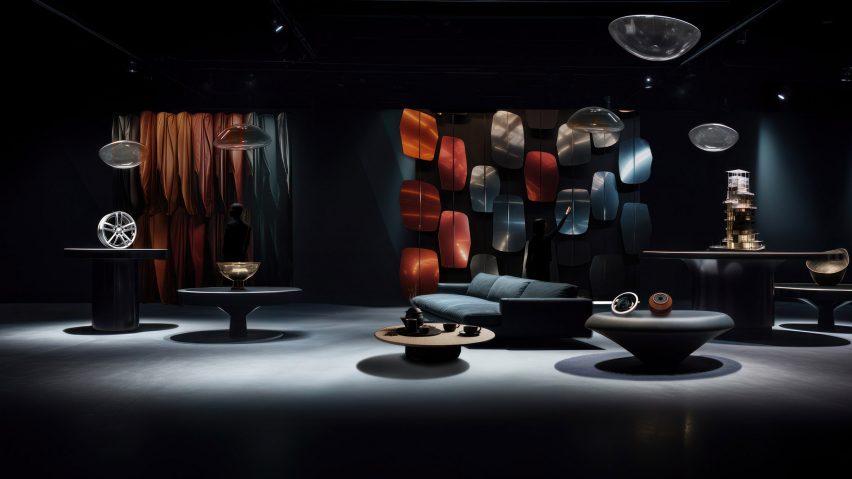
Bentley Sensorium by Most Architecture
London, UK
Uk studio Most Architecture created a futuristic customer lounge by combining a traditional showroom with the features of a museum, immersive theatre and living room.
The concept, which places a focus on real-time customisation and augmentation, enables customers to view, touch, feel and interact with objects exhibited throughout the space.
As customers interact with the various objects, surrounding screens tell the story of craftsmanship behind each item. The screens display enhanced views of the objects from unique angles, such as a macro view of leather grain or the construction sequences behind an object's creation.
Each experience would be activated by proximity, haptic feedback and voice interaction, negating the need for holding or using any additional equipment.
In real time, the screens display customisation options including materials, colours, shades and stitching, and even full car assemblies and apartment layouts.
The energy-efficient screens would be be flexibly programmed, while sensory control is implemented via shadow tracking enhanced by Braille embossing and audio cues.
"This concept of future customer lounges represents the optimal combination of richness of experience with the minimal resource consumption," the designers said.

Honey "B" Lab by Juliette Cardenas
Bogotá, Colombia
Juliette Cardenas has taken Bentley's Excellence Centre for Honey Production a step further to create the Honey "B" Lab, a research and experimentation hub focussed on honey.
The concept features a raw honey tasting spot where visitors can sample the pure produce of the local hives. The bar is designed to serve not only as a pleasurable experience, but as an educational opportunity to highlight the product's quality and bring awareness to the importance of bees for the environment.
Another part of the concept is the Gastronomic Hive, where an assortment of dishes created with honey as the hero ingredient – with both sweet and savoury flavour profiles – are served as part of a tasting menu.
The "B" Bar would feature a honey cocktail menu and distillery lab, which is designed to apply Bentley's craftsmanship to refreshments.
"In a planet of colossal mountains, endless oceans, and monumental creatures, we now understand the immeasurable value of the smallest living beings," Cardenas said.
"All bees need homes and food sources, so it will be a beautiful vision having the Bentley name associated with colourful and flowery landscapes that honour them," she continued.
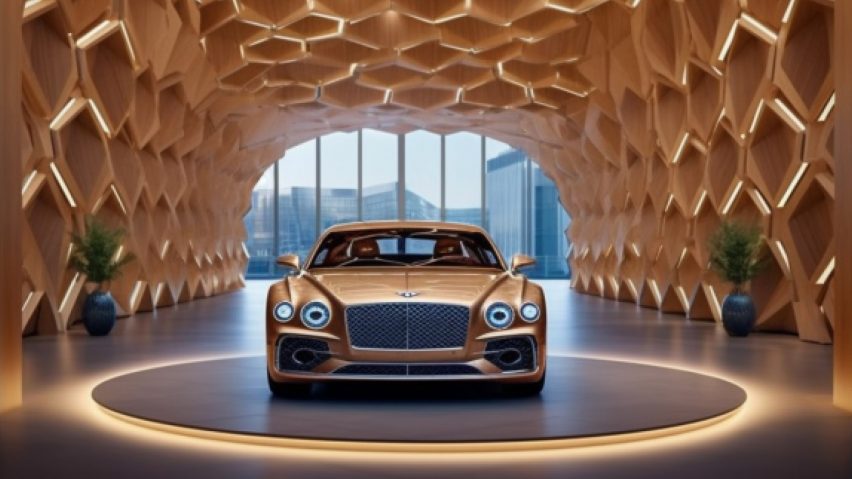
The Bentley Pavilion by Manny Kapoor
Rochester, Michigan, USA
The Bentley Pavilion, designed by Manny Kapoor, combines a physical showroom space featuring Bentley's automotive and home furnishing lines with a digital space that enables the brand's global clientele to engage and immerse themselves in the Bentley world.
The pavilion features a design studio in which customers use augmented reality and virtual reality to interact with digital interfaces. It also provides tangible product samples to personalise their products, from selecting the paint of their car to the upholstery of their sofas.
The process integrates AI-powered suggestions based on customers' preferences, making customisation intuitive and user-friendly.
The showroom makes use of solar panels, rainwater harvesting systems and energy-efficient appliances for its operations, while the virtual domain will enable carbon credits earned from customers' sustainable choices to be recorded and rewarded using blockchain technology.
"The Pavilion will serve as a haven for Bentley enthusiasts and a beacon for potential customers, showcasing the brand's prowess in both automotive and lifestyle luxury," Kapoor said.
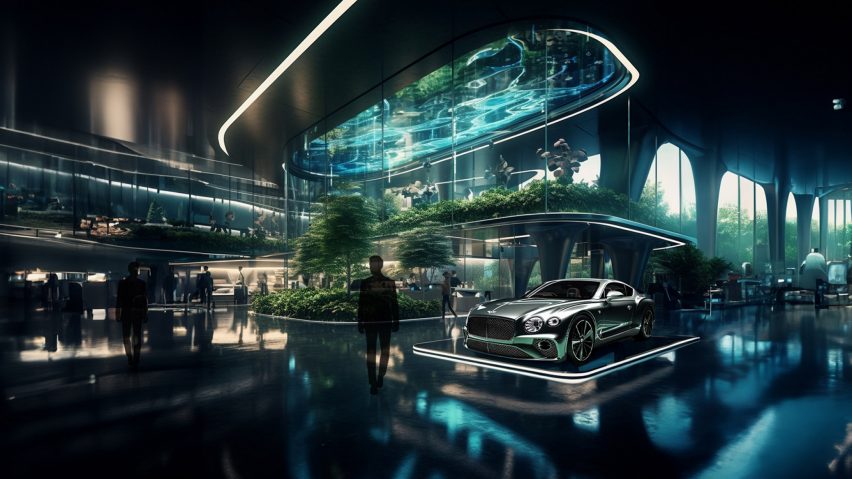
Bentley Metaverse Experience Centre by Leonid Krykhtin, Eunji Choi, Wendy Li and Wang Di
Shanghai, China
Leonid Krykhtin Design Network designed the Metaverse Experience Centre, a retail concept featuring fully immersive virtual spaces for exhibitions and events, cutting down the necessity for resource-intensive physical displays to reduce its environmental footprint and to further promote conscious consumption.
The virtual journey begins at the DNA Time Capsule, which uses VR/AR technology to enable visitors to delve into Bentley's history, achievements and aspirations.
Beyond automotive design, the centre features a virtual Lifestyle Lounge, which hosts exclusive virtual VIP events ranging from haute couture fashion shows to avant-garde art exhibitions.
Teleportation portals offer instantaneous travel across the metaverse, while the Virtual Test Track, shaped like a trefoil Mobius loop, links all key areas within the centre where guests can test-drive their custom virtual Bentley.
At the Bespoke Creation Studio, guests can partner with AI assistants to design their ideal Bentley. The studio provides advanced haptic VR gloves that enable tactile interaction with virtual samples and each design choice is visualised in real-time.
"The Bentley Metaverse Centre expands the notion of luxury, morphing it into a fully immersive, highly personalised and eco-conscious experience," the designers said.
Partnership content
The Future Luxury Retail Design Competition is a partnership between Dezeen and Bentley. Find out more about Dezeen partnership content here.